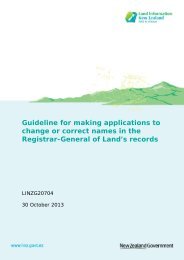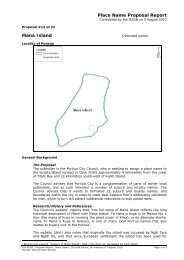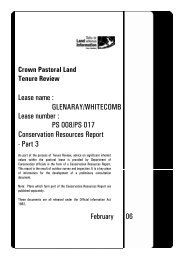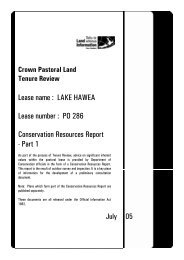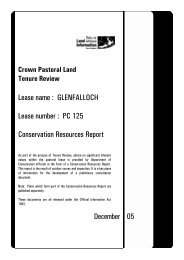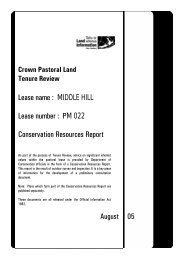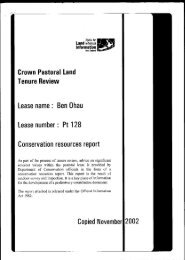Part 1 - Land Information New Zealand
Part 1 - Land Information New Zealand
Part 1 - Land Information New Zealand
You also want an ePaper? Increase the reach of your titles
YUMPU automatically turns print PDFs into web optimized ePapers that Google loves.
RELEASED UNDER THE OFFICIAL INFORMATION ACT<br />
• To maximise water yield it is necessary to maintain tall, unmodified tussock vegetation over<br />
the headwater catchments. This is best achieved by completely destocking these areas, preventing<br />
fires of any kind and controlling wilding pine tree growth.<br />
Mark and Rowley (1969) demonstrated that undisturbed snow tussocks produced a greater water<br />
yield than either a sward of blue tussock or snow tussocks which have been recently defoliated by<br />
clipping or burning.<br />
Duncan and Thomas (2004) in their study of the hydrological effects of burning tall tussock<br />
grasslands on the Lammerlaw Range showed that for the summer period, modification of tall<br />
tussock grassland did reduce water yield. Measured decreases in catchment runoff were greatest<br />
in the first two years following burning, as tussock tillers rapidly grow from surviving tussock<br />
stumps and deplete soil moisture. Duncan and Thomas concluded that “burning tall tussock<br />
grassland reduces water yield in the short term (2-3 years). It can be implied from this and other<br />
studies that if burning and grazing persist, then so will reductions in water yield.<br />
5. Water Supply and Retention<br />
Fitzharris (1979) notes that the accumulation of snow into drifts is largely controlled by microrelief<br />
in the landscape. He also makes the observation that the presence of snow tussocks assists<br />
in the accumulation of drifts or a more widespread snow pack. The annual snowmelt helps to<br />
recharge the shallow regolith storage and sustains base flow over the summer. With less cover or<br />
bare ground, freshly fallen snow tends to be blown away, by the strong winds which sweep across<br />
the uplands, leaving only the frozen bare soil or ice coated rocks (Waugh 2005).<br />
Fahey and Jackson, 1991(a) note that bogs are important water-holding areas for the headwaters of<br />
many streams helping reduce flood peaks and sustain flows. They also state that “Evaporation<br />
from tussock grasslands has important implications for water-resource management. The strong<br />
physiological control of transpiration by tall tussock produces low rates of water use in summer<br />
and contributes to the well sustained stream flow”.<br />
Duncan and Thomas (2004) found depleted tussock catchments yield lower water flows and Fahey<br />
and Jackson (1991b) attribute this in part to the higher transpiration rates from exotic pasture<br />
species.<br />
6. Erosion control and sediment retention<br />
Snow tussock catchments monitored for sediment yield elsewhere in Otago have been shown to<br />
have very low sediment yields by <strong>New</strong> <strong>Zealand</strong> standards (Waugh 2005).<br />
7. Nutrient cycling<br />
Monitoring elsewhere in Otago has shown that tussock covered catchments yield very good water<br />
quality (ORC 1999).<br />
ORC records taken in 1999 at Stonehenge on the Lammerlaw Range reveal high water quality<br />
characterised by:<br />
• Cool water temperatures<br />
• High levels of dissolved oxygen<br />
• Approximately neutral pH values<br />
• Low conductivities<br />
20



